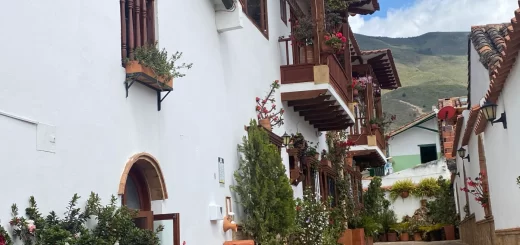Much more than Mardi Gras, New Orleans is defined by food and drink
Visitors can wash down Cajun and Creole classics with the city’s official cocktail, the Sazerac

Cindy Miller, one of 15 chefs giving classes at the New Orleans School of Cooking, welcomes those who come to learn about Cajun and Creole dishes and how they came to be traditions. The mirror above her reflects the ingredients to be used. (Janet Podolak)
New Orleans, perhaps more than any other, is a city defined by its food and drink, So even though we were joining a food-focused Mississippi River cruise in New Orleans, my friend and I arrived early so we could experience some of the city’s own food and beverage culture.
Its jambalaya, gumbo, pralines and bread pudding all are dishes closely connected to the Crescent City, and we wanted to find out why. The Sazerac is the city’s official drink.
Our demonstration class at the New Orleans School of Cooking set the tone with those recipes and showcased techniques and ingredients that helped us understand the differences between Cajun and Creole dishes. Not surprisingly, those differences are related to the people who settled New Orleans. They tell its story in tastes, better than words.

Horses with buggies await passengers on Jackson Square for those wishing to explore New Orleans’ French Quarter in style. (Cathryn Knezevich)
Driven from Nova Scotia by the English in the 1800s, many of the French-speaking Arcadians settled in the bayous around New Orleans and adapted their lifestyles to the area, becoming Cajun in the process. Their food is spicier than Creole specialties and contains more pork and crayfish. Creole people often are racially mixed, tracing their ancestry to Spain, France, Africa or the Caribbean. Their food is more likely to include tomatoes, shrimp, oysters and crab among its ingredients.
The New Orleans School of Cooking, 524 St. Louis St., is set in a renovated 1800s molasses warehouse in the heart of the French Quarter. It’s been operated by the same family since 1980 — a time when cooking schools were not as popular as they are now.
Cindy Miller, one of 15 chefs conducting the classes, suggested that the foolproof praline recipe she’d be sharing would be ideal as a Christmas gift for folks back home. Hers is a Creole recipe adapted with pecans from the sugar-coated almonds used as a digestive aid in the 1600s, but she said everyone seems to have their own versions. Humidity is the enemy of this sweet confection, so the dry winter days in our area are an advantage when making pralines.
The school’s general store is jam-packed with foods, tools, cookware and gift baskets to take home.
We learned that filé is a powder of dried young sassafras leaves used for flavor and thickening in gumbo and that the mirepoix basic of French cooking has become the “holy trinity” in New Orleans-speak, substituting finely chopped green peppers for the carrots of the French, sauteing it with chopped onions, celery and black pepper. Cooking styles and ingredients often have morphed from their French, Spanish and African origins into something uniquely New Orleans.
The same changes took place in the development of the Sazerac, which began with a pharmacist who made bitters in the early 1800s and has become the official drink of New Orleans. Its story is told at the three-story Sazerac House, at Canal and Magazine streets, on the edge of the French Quarter.

A staircase in the three-story Sazerac House is lined with a backlit wall of various spirits. Here visitors can sip, sample and explore their way through stories of drinking in New Orleans’ French Quarter. (Courtesy of Sazerac House)
Visitors there can sample, sip and explore their way through the stories, legends and spirits that have helped make the Quarter what it is today.
The cocktail’s 1600 origins in France began with ingredients that included cognac and absinthe, which was outlawed for many years because of its alleged hallucinatory properties. Rye became the substitute when cognac became unavailable, and the anise-flavored liqueur Herbsaint was created to fill in for absinthe.

The Sazerac, the official cocktail of New Orleans, is served in an old-fashioned glass and made from rye whisky, herbsaint and Peychaud’s bitters poured over a sugar cube with a lemon peel. (Janet Podolak)
Since 2007, when the prohibition of absinthe ended, several brands of the high-alcohol spirit are produced and the original Sazerac can be found.
The bitters created by the pharmacist Antoine Peychaud still carry his name and are available in the first-floor gift shop. A third-floor Sazerac House exhibit lets visitors see — and taste — how spices, citrus, nuts and botanicals contribute flavors and fragrances to the creation of bitters. Tastes of Sazerac also are part of the tour, which is free and available only to those 21 and older.
Speakeasies flourished in the French Quarter during Prohibition and cocktail parties moved into private homes, cementing the city’s cocktail culture. Residents tried to fight the law by getting spirits classified as food.
“Once, during Prohibition, I was forced to live for days on only food and water,” said W.C.. Fields. That quote is framed and hung on a wall at Sazerac House.
The easy culture of drinking was underscored in the 1960s, when go-cups became a staple in New Orleans, allowing drinks to be ordered to-go in plastic cups so those imbibing could walk around while drinking.
Public drinking is a fact of life during Mardi Gras, which began on Jan. 6 and culminates with the beginning of Lent on Feb. 13 — Fat Tuesday.

People line the streets of New Orleans for Mardi Gras, which began Jan. 6 with parades until Feb. 13 this year. (Paul Broussard)
Just as a teenage Joan of Arc led the French army to victory in 1429, the young heroine led New Orleans into carnival season on Jan. 6 – her birthday. Annually, parade-goers can expect all the costumed knights, medieval monks and fanfare of a Renaissance festival on foot. Highlights of the procession include a blessing of her sword at Joan’s golden statue at Place de France on Decatur Street.
Get planning information for a visit to New Orleans at neworleans.com.
The New Orleans School of Cooking offers a wide variety of classes. Two-hour demonstration classes, such as the one I joined, are offered at 10 a.m. and 2 p.m. and include recipes and plenty of tastes. They start at $40, and reservations are needed. Visit NOSOC.com.
The three-floor Sazerac House, at the corner of Canal and Magazine streets, is at the edge of the French Quarter. Tours are free for those 21 and older, but reservations must be made at Sazerachouse.com.



Recent Comments